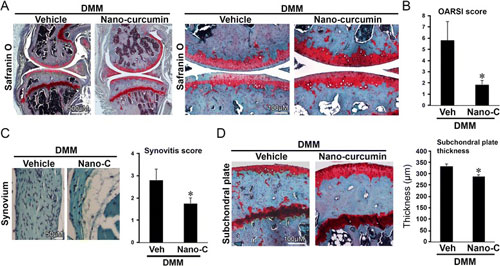| Posted: Jun 17, 2016 | |
Topically applied curcumin nanoparticles alleviates joint pain and slows progression of Osteoarthritis |
|
| (Nanowerk Spotlight) Osteoarthritis (OA) is a progressive, degenerative disease of articular joints and a leading cause of pain and disability in the adult population for which there is no non-surgical cure. | |
| Current pharmacologic treatments such as analgesics and nonsteroidal anti-inflammatory drugs (NSAIDs) provide symptomatic relief, but do not halt or reverse the disease progression and can over time, have significant side effects. | |
| "There is a clear and urgent need for new therapeutic strategies that are effective and safe for OA treatment," says Professor Joel Friedman MD, PhD, from the Dept. of Physiology and Biophysics at the Albert Einstein College of Medicine. | |
| Dr. Friedman, with Dr. Herb Sun, Associate professor and Director of the Osteoarthritis research program at Einstein, looked to Curcumin, a non-toxic, natural agent which gives the spice turmeric its yellow color, to fill this gap. | |
 |
|
| Topical application of nano-encapsulated curcumin slowed the progression of OA induced by destabilization of the medial meniscus (DMM) in mice. Mice with DMM were treated daily with topical application of curcumin nanoparticles or vehicle. Mice treated topically with curcumin nanoparticles (Nano-C) exhibited improved Safranin O staining (a), lower Osteoarthritis Research Society International (OARSI) scores (b), and reduced synovitis (c), and subchondral bone plate thickness (d) at 8 weeks after surgery compared to that in vehicle control (Veh) (*p < 0.05, t test, n = 5/group). Representative histologic images are shown. (© BioMed Central) (click on image to enlarge) | |
| Curcumin has exceptional therapeutic potential due to its capacity to limit inflammation, cell death, and provide cell protection against potent free radicals. Harnessing the therapeutic potential of curcumin has been a challenge in that it is poorly absorbed when ingested and is rapidly eliminated from the blood. | |
| To overcome these limitations, Sun and Friedman utilized a well studied nanoparticle platform used previously to deliver curcumin to MRSA-infected burn wounds and deep fungal infections (see our previous Nanowerk Spotlight: "Curcumin nanoparticles as innovative antimicrobial and wound healing agents"). | |
| In their paper published in the June 3, 2016 online edition of Arthritis Research & Therapy ("Curcumin slows osteoarthritis progression and relieves osteoarthritis-associated pain symptoms in a post-traumatic osteoarthritis mouse model"), it was shown using a mouse model of OA that curcumin loaded nanoparticles topically applied to arthritic knees stopped the progression of the disease and eliminated associated pain by locally delivering curcumin to the fat pad associated with the knee cap. | |
| The study also demonstrated several OA relevant inflammatory pathways were suppressed by curcumin, including those that result in the production of proteins that destroy cartilage. | |
| "The ability to use these nanoparticles to topically deliver therapeutically effective levels of curcumin bodes well for new drug delivery strategies for many other fat soluble drugs that are poorly absorbed and rapidly excreted," says Friedman. | |
| Additional studies involving the collaboration of the Friedman nanoparticle team with the osteoarthritis research team under Dr. Sun will address both the ability of this strategy to actually reverse the joint damage in OA and the prospects of using this platform to deliver combinations of anti-inflammatory molecules to enhance therapeutic efficacy. | |
| The nanoparticle platform is currently being commercialized by Nano Biomed Inc for numerous clinical applications. | |
|
Source: Albert Einstein College of Medicine
|
|
|
Become a Spotlight guest author! Join our large and growing group of guest contributors. Have you just published a scientific paper or have other exciting developments to share with the nanotechnology community? Here is how to publish on nanowerk.com. |
|
